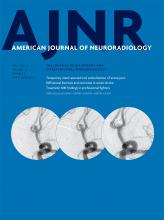Index by author
Ackermann, M.
- ADULT BRAINOpen AccessAPOE*E4 Is Associated with Gray Matter Loss in the Posterior Cingulate Cortex in Healthy Elderly Controls Subsequently Developing Subtle Cognitive DeclineS. Haller, M.-L. Montandon, C. Rodriguez, M. Ackermann, F.R. Herrmann and P. GiannakopoulosAmerican Journal of Neuroradiology July 2017, 38 (7) 1335-1342; DOI: https://doi.org/10.3174/ajnr.A5184
Afat, S.
- EDITOR'S CHOICEINTERVENTIONALYou have accessTemporary Stent-Assisted Coil Embolization as a Treatment Option for Wide-Neck AneurysmsM. Müller, C. Brockmann, S. Afat, O. Nikoubashman, G.A. Schubert, A. Reich, A.E. Othman and M. WiesmannAmerican Journal of Neuroradiology July 2017, 38 (7) 1372-1376; DOI: https://doi.org/10.3174/ajnr.A5204
The authors intended to treat 33 aneurysms between January 2010 and December 2015 with temporary stent-assisted coiling, which formed the series for this study. Incidental and acutely ruptured aneurysms were included. Sufficient occlusion was achieved in 97.1% of the cases. In 94%, the stent could be fully recovered. Complications occurred in 5 patients (14.7%). They conclude that temporary stent-assisted coiling is an effective technique for the treatment of wide-neck aneurysms. Safety is comparable with that of stent-assisted coiling and coiling with balloon remodeling.
Al-dasuqi, K.
- EDITOR'S CHOICEADULT BRAINOpen AccessThe Use of Noncontrast Quantitative MRI to Detect Gadolinium-Enhancing Multiple Sclerosis Brain Lesions: A Systematic Review and Meta-AnalysisA. Gupta, K. Al-Dasuqi, F. Xia, G. Askin, Y. Zhao, D. Delgado and Y. WangAmerican Journal of Neuroradiology July 2017, 38 (7) 1317-1322; DOI: https://doi.org/10.3174/ajnr.A5209
The authors evaluated 37 journal articles that included 985 patients with MS who had MR imaging in which T1-weighted postcontrast sequences were compared with noncontrast sequences obtained during the same MR imaging examination by using ROI analysis of individual MS lesions. DTI-based fractional anisotropy values were significantly different between enhancing and nonenhancing lesions, with enhancing lesions showing decreased FA. None of the other most frequently studied MR imaging biomarkers (mean diffusivity, magnetization transfer ratio, or ADC) were significantly different between enhancing and nonenhancing lesions. They conclude that noncontrast MR imaging techniques, such as DTI-based FA, can assess MS lesion acuity without gadolinium.
Allen, J.W.
- You have accessReply:F.H. Chokshi, G. Sadigh, W. Carpenter and J.W. AllenAmerican Journal of Neuroradiology July 2017, 38 (7) E50; DOI: https://doi.org/10.3174/ajnr.A5202
Ambady, P.
- PATIENT SAFETYOpen AccessWhat Does the Boxed Warning Tell Us? Safe Practice of Using Ferumoxytol as an MRI Contrast AgentC.G. Varallyay, G.B. Toth, R. Fu, J.P. Netto, J. Firkins, P. Ambady and E.A. NeuweltAmerican Journal of Neuroradiology July 2017, 38 (7) 1297-1302; DOI: https://doi.org/10.3174/ajnr.A5188
Amor-sahli, M.
- FELLOWS' JOURNAL CLUBEXTRACRANIAL VASCULARYou have accessTIPIC Syndrome: Beyond the Myth of Carotidynia, a New Distinct Unclassified EntityA. Lecler, M. Obadia, J. Savatovsky, H. Picard, F. Charbonneau, N. Menjot de Champfleur, O. Naggara, B. Carsin, M. Amor-Sahli, J.P. Cottier, J. Bensoussan, E. Auffray-Calvier, A. Varoquaux, S. De Gaalon, C. Calazel, N. Nasr, G. Volle, D.C. Jianu, O. Gout, F. Bonneville and J.C. SadikAmerican Journal of Neuroradiology July 2017, 38 (7) 1391-1398; DOI: https://doi.org/10.3174/ajnr.A5214
This study included 47 patients from 10 centers presenting between January 2009 through April 2016with acute neck pain or tenderness and at least 1 cervical image showing unclassified carotid abnormalities. The authors conducted a systematic, retrospective study of their medical charts and diagnostic and follow-up imaging. All patients presented with acute neck pain, and 8 presented with transient neurologic symptoms. Imaging showed an eccentric pericarotidian infiltration in all patients. An intimal soft plaque was noted in 16 patients, and a mild luminal narrowing was noted in 16 patients. The authors conclude that this study improves the description of an unclassified, clinico-radiologic entity, which could be described by the proposed acronym: Transient Perivascular Inflammation of the Carotid artery (TIPIC) syndrome.
An, H.S.
- EXTRACRANIAL VASCULARYou have accessAppropriate Minimal Dose of Gadobutrol for 3D Time-Resolved MRA of the Supra-Aortic Arteries: Comparison with Conventional Single-Phase High-Resolution 3D Contrast-Enhanced MRAS.H. Bak, H.G. Roh, W.-J. Moon, J.W. Choi and H.S. AnAmerican Journal of Neuroradiology July 2017, 38 (7) 1383-1390; DOI: https://doi.org/10.3174/ajnr.A5176
Aptel, F.
- HEAD & NECKYou have accessThe Central Bright Spot Sign: A Potential New MR Imaging Sign for the Early Diagnosis of Anterior Ischemic Optic Neuropathy due to Giant Cell ArteritisP. Remond, A. Attyé, A. Lecler, L. Lamalle, N. Boudiaf, F. Aptel, A. Krainik and C. ChiquetAmerican Journal of Neuroradiology July 2017, 38 (7) 1411-1415; DOI: https://doi.org/10.3174/ajnr.A5205
Aragao, M.F.V.V.
- PEDIATRICSOpen AccessNonmicrocephalic Infants with Congenital Zika Syndrome Suspected Only after Neuroimaging Evaluation Compared with Those with Microcephaly at Birth and Postnatally: How Large Is the Zika Virus “Iceberg”?M.F.V.V. Aragao, A.C. Holanda, A.M. Brainer-Lima, N.C.L. Petribu, M. Castillo, V. van der Linden, S.C. Serpa, A.G. Tenório, P.T.C. Travassos, M.T. Cordeiro, C. Sarteschi, M.M. Valenca and A. CostelloAmerican Journal of Neuroradiology July 2017, 38 (7) 1427-1434; DOI: https://doi.org/10.3174/ajnr.A5216
Arnold, M.
- INTERVENTIONALYou have accessImpact of Anesthesia on the Outcome of Acute Ischemic Stroke after Endovascular Treatment with the Solitaire Stent RetrieverA. Slezak, R. Kurmann, L. Oppliger, A. Broeg-Morvay, J. Gralla, G. Schroth, H.P. Mattle, M. Arnold, U. Fischer, S. Jung, R. Greif, F. Neff, P. Mordasini and M.-L. MonoAmerican Journal of Neuroradiology July 2017, 38 (7) 1362-1367; DOI: https://doi.org/10.3174/ajnr.A5183



